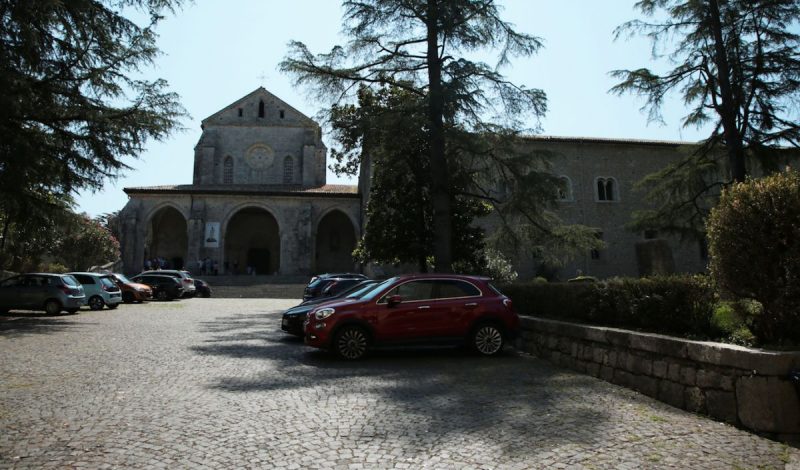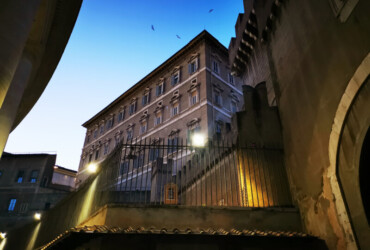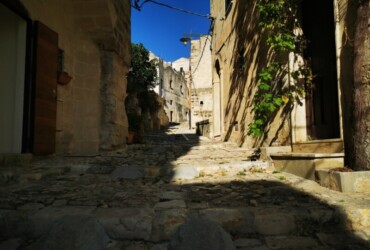Living in Rome allows me always to find something to do and someplace to visit (not ever far from the city). In July, one Sunday morning, I decided to take a tour of the Cistercian abbey of Casamari and Isola del Liri (a small village famous for the waterfall that “cuts in half” the town).
Casamari Abbey
It is one of the most important Italian monasteries of Cistercian Gothic architecture.
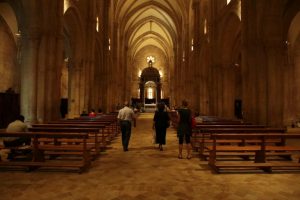 Located in the municipality of Veroli, Province of Frosinone, the abbey of Casamari was built in 1203 and consecrated in 1217. It is located. In June 1957 it was elevated to a minor basilica by Pope Pius XII. The abbey was built on the ruins of the ancient Roman municipality called “Cereatae” because it was dedicated to the goddess Ceres, and the name Casamari comes from the Latin and means “House of Mario”, home of Gaius Marius (leader, consul and adversary of Silla in the war civil law of 88 BC). With the decline of the Roman Empire and the barbarian invasions, Casamari suffered the same fate. In the 11th century, however, the Benedictine monks who founded the abbey arrived here. We have some news about the foundation of the monastery thanks to the “Cronaca del Cartario” (or Chartarium Casamariense) written by the Casamari Monaco Gian Giacomo de Uvis: it seems that, in 1005, some monks from nearby Veroli decided to meet in a monastery and chose Cereatae – Casa Marii building the building on the remains of what was a temple dedicated to Mars. Some of the monks (Benedetto, Giovanni, Orso and Azo) went to the monastery of Sora to request the monastic habit.
Located in the municipality of Veroli, Province of Frosinone, the abbey of Casamari was built in 1203 and consecrated in 1217. It is located. In June 1957 it was elevated to a minor basilica by Pope Pius XII. The abbey was built on the ruins of the ancient Roman municipality called “Cereatae” because it was dedicated to the goddess Ceres, and the name Casamari comes from the Latin and means “House of Mario”, home of Gaius Marius (leader, consul and adversary of Silla in the war civil law of 88 BC). With the decline of the Roman Empire and the barbarian invasions, Casamari suffered the same fate. In the 11th century, however, the Benedictine monks who founded the abbey arrived here. We have some news about the foundation of the monastery thanks to the “Cronaca del Cartario” (or Chartarium Casamariense) written by the Casamari Monaco Gian Giacomo de Uvis: it seems that, in 1005, some monks from nearby Veroli decided to meet in a monastery and chose Cereatae – Casa Marii building the building on the remains of what was a temple dedicated to Mars. Some of the monks (Benedetto, Giovanni, Orso and Azo) went to the monastery of Sora to request the monastic habit.
 Between 1140 and 1152 the Cistercian monks replaced the Benedictine monks. Between the twelfth and nineteenth centuries, however, the monastery had mixed fortunes: at first it acquired possessions in the area (including the church of Sant’Angelo de Meruleta in Castro dei Volsci) and started the foundation of new monasteries also in the South, while at the beginning of the fifteenth century a period of decay began. In 1623 there were only eight monks. There was a brief period of prosperity after 1717 when Pope Clement XI entrusted the structure to the Trappist monks. In 1799 some French soldiers plundered the abbey.
Between 1140 and 1152 the Cistercian monks replaced the Benedictine monks. Between the twelfth and nineteenth centuries, however, the monastery had mixed fortunes: at first it acquired possessions in the area (including the church of Sant’Angelo de Meruleta in Castro dei Volsci) and started the foundation of new monasteries also in the South, while at the beginning of the fifteenth century a period of decay began. In 1623 there were only eight monks. There was a brief period of prosperity after 1717 when Pope Clement XI entrusted the structure to the Trappist monks. In 1799 some French soldiers plundered the abbey.
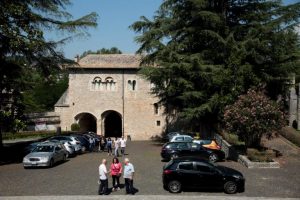 In 1874 the abbey was declared a national monument, thus resuming a prestigious position (with consequent economic stability). In 1929 the congregation of Casamari was canonically erected as a religious congregation and aggregated to the others of the Cistercian order. The entrance has a double-arched door, and the abbey has a plan similar to that of French monasteries. Inside is a garden in the centre of which is a square-shaped cloister: from the sanctuary you enter the church, with a basilical plan with three naves. A very particular thing is represented by the windows of the church, which have slabs of alabaster instead of glass.
In 1874 the abbey was declared a national monument, thus resuming a prestigious position (with consequent economic stability). In 1929 the congregation of Casamari was canonically erected as a religious congregation and aggregated to the others of the Cistercian order. The entrance has a double-arched door, and the abbey has a plan similar to that of French monasteries. Inside is a garden in the centre of which is a square-shaped cloister: from the sanctuary you enter the church, with a basilical plan with three naves. A very particular thing is represented by the windows of the church, which have slabs of alabaster instead of glass.
Isola del Liri
This small village, in the province of Frosinone, is known for the waterfall located right in the centre of the town itself.
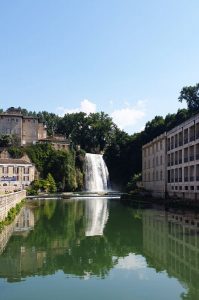 The historic centre of the small town is developed on an island formed by the river Liri which is divided into two branches at the Boncompagni – Viscogliosi castle. Each branch creates a jump of thirty meters: the Great Waterfall (Vertical) and the Cascata del Valcatoio (or, anciently, of the Gualcatojo or even Cascatelle). The Grande Cascata, of which I spoke to you a little above, is formed by the left arm of the river and is about 27 meters high: it is one of the few waterfalls that are located in the historic centre of a city. The Cascata del Valcatoio, formed by the right arm of the river, is less spectacular than the first and its jump is not perfectly vertical but follows an inclined plane of about 160 meters along a gradient of about 27 meters.
The historic centre of the small town is developed on an island formed by the river Liri which is divided into two branches at the Boncompagni – Viscogliosi castle. Each branch creates a jump of thirty meters: the Great Waterfall (Vertical) and the Cascata del Valcatoio (or, anciently, of the Gualcatojo or even Cascatelle). The Grande Cascata, of which I spoke to you a little above, is formed by the left arm of the river and is about 27 meters high: it is one of the few waterfalls that are located in the historic centre of a city. The Cascata del Valcatoio, formed by the right arm of the river, is less spectacular than the first and its jump is not perfectly vertical but follows an inclined plane of about 160 meters along a gradient of about 27 meters.
Already in a document of 1004, there is a place in the Sorano county called Colle dell’Isola, but the first registered name of the city was Insula Filiorum Petri, i.e. Island of the sons of Pietro, steward of Sora. Following the national unification, in 1863 Isola became Isola near Sora and then in 1869 it obtained its current name.
The village is really very small, apart from the waterfall in the centre does not offer much, but if you are in the area undoubtedly worth taking a walk through its alleys.

